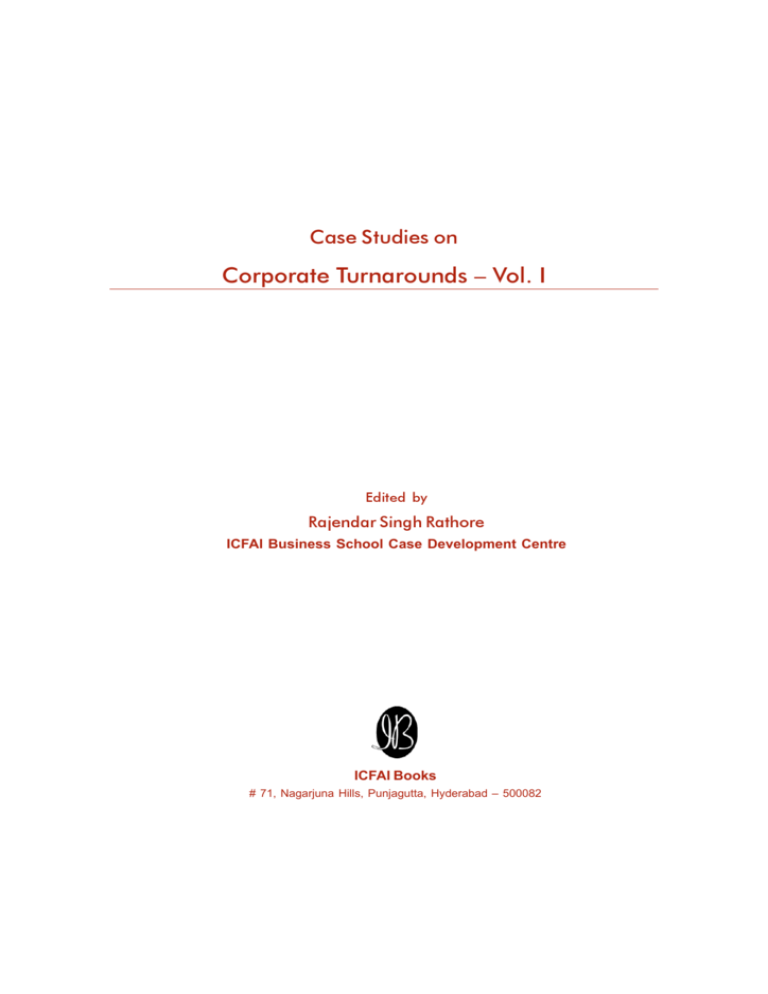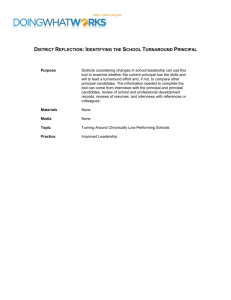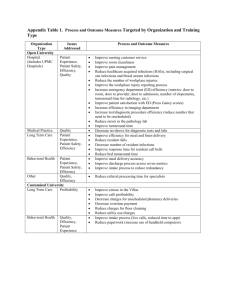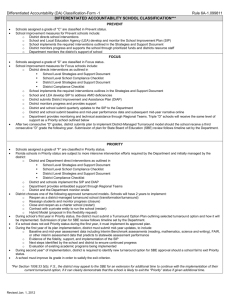
Case Studies on
Corporate Turnarounds – Vol. I
Edited by
Rajendar Singh Rathore
ICFAI Business School Case Development Centre
ICFAI Books
# 71, Nagarjuna Hills, Punjagutta, Hyderabad – 500082
ICFAI Books
# 71, Nagarjuna Hills,
Punjagutta, Hyderabad – 500082
Andhra Pradesh, INDIA
Phone: 91 - 40 - 23435387/91, Fax: 91 - 40 - 23435386
e-mail: icfaibooks@icfai.org, ibscdc@icfai.org
Website: www.icfaipress.org/books, www.ibscdc.org
© 2006 The Institute of Chartered Financial Analysts of India. All rights reserved.
No part of this publication may be reproduced, stored in a retrieval system, used in a
spreadsheet, or transmitted in any form or by any means – electronic, mechanical,
photocopying or otherwise – without prior permission in writing from The Institute of
Chartered Financial Analysts of India.
While every care has been taken to avoid errors and omissions, this book is being
sold on the condition and understanding that the information given in the book is
merely for reference and must not be taken as having authority of or being binding in
any way on the authors, editors, publisher or sellers.
Product or corporate names may be registered trademarks. These are used in the
book only for the purpose of identification and explanation, without intent to infringe.
Case studies are intended to be used as a basis for class discussion rather than to
illustrate either effective or ineffective handling of a management situation.
Copies of individual case studies are available for purchase from www.ibscdc.org
ISBN 81-314-0339-4
Editorial Team: Priyanka Ramgopal and R.V. Harnoor
Visualiser: Ch. Yugandhar Rao
Designer: Mrugasira A.
Case Title
Page No.
A&M’s Turnaround Formula for Interstate
Bakeries Corporation: The Testing Times
1
AirTran Airways: The Turnaround
17
Cisco’s Turnaround: John T Chambers’ Strategy
29
Deutsche Telekom – A Turnaround
43
Fiat Auto: Turning Around the Turnaround Strategies?
63
Humana Inc.: Turnaround of a Health Insurer
75
Indian Bank’s Turnaround Strategy
97
Infineon: Signs of a Recovery
111
Janus Capital Group: The Revival of the American
Mutual Fund Company
123
LNM: Turning Around Sick Steel Plants
141
Lucent Technologies: The Resurrection
153
Mazda’s Magical Turnaround
163
McDonald’s “Plan To Win” Strategy: The Payoffs
175
Nissan and Mitsubishi: A Tale of Two Turnarounds
185
Reinventing the Buick Magic
205
Shinsei Bank: A Turnaround
215
Turnaround Efforts at Sun Microsystems
233
Tata Tele Services Ltd.: Setting up a New Connection
239
Turnaround Efforts at Ford
249
Tyco International Ltd.: The Revival Strategies
255
VIP: The Indian Luggage Carrier’s Turnaround Strategies
265
Volkswagen: Bernd Pischetsrieder’s Turnaround Efforts
275
AN OVERVIEW
“When firms are doing so badly that failure seems imminent, only turnaround management
can restore performance and profitability.”1
With the increasing competition, rapid advances in technology and rising complexity of the
business conditions accompanied by blend of customers and employees, the challenges
for any corporate have been rising. Only a timely response to this situation can save
organisations. However, due to management inefficiency, most of the corporates fail to
identify the problems and therefore delay in taking precautionary measures affecting the
owners, employees, customers, suppliers and the economy. To restore the organisation on
its normal course, a corporate turnaround is essential.
A corporate turnaround is ‘a substantial and sustained positive change in the performance
of a business’. A business usually opts for a turnaround due to several years of declining
profitability often leading to significant losses and in severe cases, destabilising the financial
viability of the enterprise. The declining business impacts negatively on the market
competitiveness, the employee morale and the customer confidence.
A business failure can be due to various reasons mainly categorised as social, economic,
legal and managerial. An unsuccessful business is usually considered as a negative economic
event by the society. Apart from a negative image, the suppliers, creditors and employees
of the business have to bear the second-order effects. Due to the decreasing demand, the
suppliers lose their business; the customers are also forced to shift to other alternatives.
Whether a firm disintegrates early or continues to flourish forever depends on the
management’s response to a particular crisis. The problem usually heightens when the
organisation is in a transformation stage and fails to recognise in time, the significant crises
occurring in the organisation’s life cycle. Most organisations have difficulty in identifying
the crises and act late. The financial crises being finite in terms are easily identifiable; on the
other hand, the non-financial critical situations are left to subjective discretion of the
management. Therefore, failure to cope with the non-financial situations like people and
organisational problems, lead to future financial crises.
Apart from these internal factors, external factors like political, economic and stock price
also play a decisive role in the decline of an organisation. It includes role of unions,
governmental regulations, safety and health improvement measures, consumer organisation
pressures, shortage of energy and raw materials, change in technology etc. However,
research shows that external causes play minimal role compared to the internal causes in
stifling the fortunes of an organisation (Table I).
1
Slatter, Stuart “Corporate Turnaround – Managing Companies in Distress”, http://books.global-investor.com/books/
10638.htm?ginPtrCode=00000&identifier
i
Table I
The Principal Reasons for Corporate Decline
Reasons
Sheer Bad Luck
External factors beyond management’s control
Real balance of external and internal factors
Internal problems triggered by external factors
Internally generated problems within management’s control
Total
Percent
1
8
24
15
52
100
Source: Bibeault, B. Donald “Is Decline Externally or Internally Caused”, Corporate Turnaround –
How Managers Turn Losers Into Winners!, page 25
The internal reasons mostly depend on the management style. It can be due to incompetence,
narrow vision, displacement activity (i.e. doing things which he likes rather than what he
should do), lack of managerial depth, management change problems, inbred bureaucratic
management, unbalanced top management team, weak finance function (i.e. inadequate
financial and accounting control) and/or non-participative board director.
The most common errors of bad management are the failure to keep pace with changes in
the marketplace and lack of operating control (i.e. budgetary control problems, product
costing, responsibility accounting, asset accounting/valuation and cash flow forecasting).
Despite the indications of business decline like falling profits and market share, the
management pretends to ignore it and fall into the death spiral of secrecy, blame and
passivity, leading to delay in corrective measures. Therefore, an effective manager should
identify problems at right time and also foresee the future challenges. Before carrying out
a corporate turnaround, he should go for a psychological turnaround to restore people’s
confidence in themselves and others. He should replace the secrecy, blame and passivity
with dialogue, respect and initiative (Box I).
There are various warning signals like mathematical forecasting method used to red-flag
potential bankruptcies, the adverse trend signals and adverse behavioural signals.
Mathematical forecasting signals include the z-score method, Gambler’s Ruin prediction of
bankruptcy and auditors “going concern” opinions. Adverse trend signals are more
subjective in nature and include parameters like declining margins, declining market share,
rapidly increasing debt, rapid employee turnover rate and rate of reinvestment. In the
adverse behaviour signals, poor communication and low employee morale are some of the
important signals. Therefore, after identifying the critical situation of the business, its the
management’s responsibility to ramp up the business by means of various turnaround
strategies.
ii
Box I
The Death Spiral
secrecy and denial
blame and scorn
avoidance and turf protection
passivity and helplessness
Contd...
iii
Avoidance and
turf protection –
avoiding meetings
and other peer
interactions
Collaboration –
promoting
collective
commitments to
new courses of
action
Passivity and
helplessness –
feeling powerless
to make a
difference in the
company’s
fortunes
Initiative – making
people believe they
can change things
Kitts
formed
cross-matri
committees with representati
functions on which a business
The new view across the
revealed opportunities hard fo
to see by itself. A result?
powered toothbrush – born of
between a US and German divi
Dyke forced managers to think
and fostered idea generation
down and bottom up through
Making it Happen” brainstorm
Ten thousand of the BBC’s
participated. They submitted 2,
of which were implemented. D
responded to many of the
inspiring managers to act fast
up special funds to pay for proj
by staff.
Source: Kanter, Moss Rosabeth “Leadership and Psychology of Turnarounds (HBR OnPoint Enhanced
Edition)”, http://harvardbusinessonline.hbsp.harvard.edu, June 1 st 2003
TYPES OF TURNAROUNDS
The principal types of turnarounds include management process turnaround, economic or
business cycle turnaround, competitive environment turnaround, product breakthrough
turnaround and government-related turnaround.
The management process turnaround means a major change in the management processes
to accomplish a turnaround. If the principal reason for decline in business was due to
management problem, the correction of these management problems that caused the decline
would be the focus of the turnaround.
If the failure of the business is due to various economic reasons, then the turnaround is
called an economic or business cycle turnaround. These economic reasons are mostly
common for cyclical industries like real estates. A sudden boom in the market will profiteer
the business while turn it bankrupt in the other case. An effective economic turnaround
tries to keep the business running until there is a boom in the economy. It also includes
strategies related to reconsideration and redirection of company’s product lines, tight
control over economies of scale and intensive focus on the development of right products
and market niche. Sustaining the business in these types of turnarounds are usually
considered to be a difficult task and hence the requirement of a leadership style that
maintains entrepreneurial drive and commitment among its key managers.
iv
The economic and competitive factors also assist the business in turnarounds and hence
called competitive environment turnarounds. Various factors like increased industry volume
and competitive price increase, acts as main enhancements in the competitive turnarounds.
The product breakthrough turnarounds are very rare, but can cause a significant reversal in
the organisation’s fortunes. These turnarounds can be due to a breakthrough in consumer
tastes and technical or scientific breakthroughs. However, in case of these turnarounds,
the right timings and right products play a critical role. Selection of a wrong product could
lead to huge losses both in terms of financials and customers.
The government-related turnarounds, on the other hand, directly or indirectly depend on
the governmental role in turning a company around. It can be either direct government
intervention/assistance or can be due to major governmental procurement and policy
changes.
THE STAGES OF A TURNAROUND
The turnarounds are divided into five stages – the management change stage, the evaluation
stage, the emergency stage, the stabilisation stage and the return-to-normal growth stage.
1.
The Management Change Stage: When a company encounters a major problem
and has to do something to solve it, a major question arises – can the present
management take necessary action to address the situation? In majority of the
cases, the managerial replacement is sought as a good option since they were
inefficient in solving the problem or were themselves a problem for the business
that caused the organisational decline. A change in the top management is required
because they failed in identifying the problem at an early stage and take precautionary
measures to contain it. Top management change means a change in the leadership,
providing a new thrust to the business to take tough decisions. And hence can
mean a change in just the CEO or COO position.
Once the organisation recognises the need for management change, the next job of
the board of the directors is to select a new leader. The new leader can be an insider,
i.e. from the organisation itself heading some other division, or can be an outsider,
i.e. from some other organisation who has a good record of handling such situations.
The selection of an insider would be advantageous as he has been working with the
organisation and is much familiar with its operations but could be dangerous as well
since he might have been involved in the earlier management that led to the
organisational decline and therefore might attempt to cover their misdeeds.
Therefore, usually an outsider is preferred to lead the company in distressed
situations as he can evaluate the situation more objectively and can take more
drastic measures without being biased to any segment.
v
Evaluation Stage: It focuses on the viability of the company and its preparation for
the turnaround. It requires identification of problems and finding solutions for the
same. The turnaround executive first finds out at what stage of seriousness the
organisation is. There are three general levels – the survival (wherein there is a
danger of bankruptcy and needs a drastic action plan), continuing losses (i.e. a
company is in constant losses but its survival is not yet threatened) and declining
business position (i.e. its market share and profitability are constantly declining and
the business would start gaining losses if the trend continues for few years).
Therefore, one of the immediate key actions involve gathering information. The
preliminary viability analysis like strength and weakness of the organisation (SWOT),
evaluation of its financial strength (its balance sheets and cash flows), its competitive
position, market position and marketing organisation’s effectiveness, evaluation of
its personnel resources etc. helps judge the company’s current ‘strategic health’
and company’s current ‘operating health’.
Therefore, by ranking the company’s strategic health and operating health as strong,
average, or weak, a three-by-three matrix with nine possible combinations is generated
(Table II). The matrix helps in identifying the strategic or operational problem of the
organisation. An organisation with a strong operating and strategic position would
not need a turnaround. On the other hand, a company with weak position in both
the categories definitely requires a turnaround as it could also be on the verge of
bankruptcy. Liquidation is considered as the best option for such firms.
Table II
Strategic/Operational Evaluation Matrix
Strategic Health
Strong
Operational Health
2.
Average
Weak
Strong
Average
Weak
Source: Bibeault, B. Donald “The Evaluation Stage”, Corporate Turnaround – How Managers
Turn Losers Into Winners!, page 226
However, the companies falling between these two extremes require turnarounds
based on the severity of its position in any one category. An operating turnaround
is suggested when there is a weak operating position and average or strong strategic
position. On the other hand, strategic turnaround is considered for companies that
vi
have an average operating position and an average or weak strategic position. A
firm with strong strategic position and an average operating position does not
usually entail for a turnaround but aggressive action plans are suggested for
improving operating efficiencies and net earnings.
After evaluating the type of turnaround required by analysing the matrix, the
management carves out an action plan highlighting the various strategies to be
followed and the detailed functional actions. The action plan generally consists of
four basic elements – objectives, strategies, tactical plans and follow-up reviews
(Table III). Once the action plan is crafted, the next responsibility is to communicate
it both upward (i.e. the board members for its approval) and downward (to the key
Table III
Contrasting Elements in the Business Plan by Turnaround Stage
Planning
Emergency Plan
Objective(s) Survival, return to
positive cash flow
Stabilisation Plan
Return-to-growth Plan
Profit improvement, earn Growth and development,
acceptable ROI
growth in market share
Strategies
Liquidation/divestment, Divestment, product-mix Acquisition, new
product elimination,
enhancement, improve
products, new markets,
head count cuts
operations, reposture the increase market penetration
business
Tactics
Asset redeployment,
cash flow analysis, debt
restructuring,
working-capital
improvements,
profitability analysis,
shutting down
operations, reducing
manpower, overhead
reduction, marketing
management, human
resource management
Liquidity improvement,
balance sheet cleanup,
control system
development, managerial
accounting development,
profit improvement
programs, development
of manufacturing
efficiencies, marketing
management, improving
people mix
Review and “Hands-on”
Managerial accounting
control
management, daily and emphasis, weekly
weekly cash reports
operations re-reviews,
monthly profit and
loss reviews
Creative financing schemes,
tight financial discipline,
efficient investment of
human and capital resources,
management by objectives,
expanding margins through
product mix changes,
building a management
development program,
reorganising for faster
growth, modifying
compensation programs
In addition to stabilisation
controls, quarterly
planning reviews
Source: Bibeault, B. Donald “Planning Strategies in Turnaround Situations”, Corporate Turnaround –
How Managers Turn Losers Into Winners!, page 239
vii
managerial team involved in the turnaround process). The action plan should also
be presented to the key external parties like the bankers, major creditors and
shareholders so as to regain their lost confidence.
3.
Emergency Stage: It marks the survival stage of the company with priority to
containing the cash overflow. It can be in terms of workforce reduction, improved
operational management and elimination of loss-making subsidiaries. In a severe
crisis, the management may even opt for divestment or liquidation of a particular
division so as to avoid additional cash flow losses. To eliminate the operating cost,
the organisation may divest whole product lines, shut down operations, reduce
manpower significantly, reduce inventory investment, tightly control purchasing
activities and focus on increasing the productivity.
4.
Stabilisation Stage: After eliminating the losses and controlling the cash flows, the
next stage is to achieve an acceptable return on investment. Apart from regular cash
flows, the emphasis is on profitability, improved business operations and revival of
the business. Reposturing the business is also stressed and involves planned
withdrawal from unprofitable products, services and market segments/territories.
The plan also involves development of alternative businesses through identification
of new market niche or acquisition of related businesses. The financial management
involves liquidity improvement, balance sheet cleanup, control system development
and managerial accounting development. On the other hand, the operations
management involves profit improvement programs, development of manufacturing
efficiencies and overhead value analysis.
5.
Return-to-Normal Growth Stage: It focuses on development and revenue growth
of the business with emphasis on internal and external development. It includes
adding new products, developing additional markets and improving the customer
services, thereby facilitating revenue growth. In order to sustain a long-term growth
and to make valuable investments, a sound financial platform for the business is
required. Therefore, the organisation has to take into consideration the balance
sheets and return on investment so as to position the company for a ten to fifteen
years down the line. The organisation starts investing in the operational capabilities
to enhance the productivity and capacity. Increased emphasis is also laid on
marketing to explore new customer markets, improved products and new products.
To develop the human resources, the management also introduces motivation and
development programs.
After the organisation returns to normal growth, the turnaround leader looks for some
definite signs like dramatic profit improvement and the increasing faith of creditors and
financial partners that starts treating the organisation as a customer again. However, the
decision of the turnaround leader can also change as there are no well-set standards to
measure the success of a turnaround and problems can arise any time. Therefore, generally
a turnaround leader continues its turnaround strategies for a two to three year period and
viii
apart from profit generation, also concentrates on rebuilding its lost market share and
regain customer’s and shareholder’s confidence.
Since the turnarounds are mostly management process turnarounds, the management style
plays a key role in the success of a turnaround. Generally, the management style pursued
by turnaround specialists involves use of hands-on management style, introduction of
tight controls (i.e. budgetary controls, product margin and cost controls and improved
responsibility accounting) and stress on employee motivation. The delegation of absolute
authority to the new management by the board also plays a key role in the managerial
process turnaround. Most of the turnaround specialists use the ‘back to basics’ strategy
i.e. concentrating on their core business. To bring the core business back to profitability,
various strategies like capital investments and different marketing approaches are
considered. On few occasions, despite being profitable and attractive, the companies have
to divest few of its non-core businesses so as to focus on its core business.
Apart from meeting these survival needs, the management also has to sustain the employees’
motivation as it plays a key role in defining the success of a turnaround. Therefore, to
complete the turnaround cycle, the turnaround leader keeps the employee morale high and
infuse in them positive thinking. He has the challenge of changing the attitude and culture
of the company and therefore once the organisation reaches the growth stage, the
management shifts the organisational focus towards various human resource development
programs as a part of culture change.
Quite often, in a corporate turnaround, the basic business beliefs and philosophies are
reversed, thereby making them a very difficult task for any turnaround manager. The
management has to face severe and continuous challenges, both internally and externally.
However, the challenges can be transformed into opportunity by responding appropriately
at right time. And effective management, the instrument that is the heart of the company,
can do this.
Therefore, corporate failure and its turnaround being a crucial part of any organisation, it is
necessary for a management to understand the reasons for a decline and find various ways
to avoid a potential bankruptcy. With an aim to provide valuable insights into these factors
and to capture the management lessons for a corporate, the book has compiled some of the
finest case studies on turnaround efforts of some of the famous corporates.
This book consists of twenty-two case studies on some of the world’s most remarkable
turnaround cases in contemporary times, notably Nissan, Mitsubishi, Cisco, Deutsche
Telekom, Mazda, Fiat Auto, AirTran, Humana Inc., and Ford. These case studies, covering a
wide range of diverse industries – airlines, automobile, computer hardware, telecommunications,
banking and financial services etc. provide valuable insights into a wide spectrum of underlying
reasons that push companies into trouble. One can also learn, by taking recourse to a radical
thinking, how these companies could turn their fortunes around.
ix
The case studies, Turnaround Efforts at Ford, Volkswagen: Bernd Pischetsrieder’s
Turnaround Efforts, Tyco International Ltd.: The Revival Strategies and A&M’s Turnaround
Formula for Interstate Bakeries Corporation: The Testing Times, illustrate the strategic
missteps of these companies and the turnaround efforts being undertaken by the
management to revive the companies.
On the other hand, case studies like Nissan & Mitsubishi: A Tale of Two Turnarounds,
LNM: Turning Around Sick Steel Plants and Mazda’s Magical Turnaround, highlights
the success stories of the corporates that had timely identified the need for turnaround and
by means of various strategies were able to successfully turn the company around.
x








